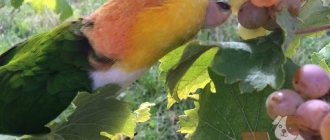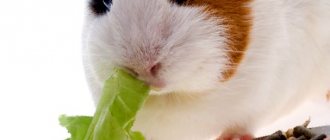Feeding hamsters grapes: pros and cons
Excerpt from Wikipedia
Positive points:
- The functioning of the rodent's cardiovascular and genitourinary systems improves. As a result, your pet’s life expectancy increases.
- Blood circulation is normalized and overall blood quality improves.
Negative points:
- A lot of sugar. Djungarians have problems with sugar.
- May cause bloating and increased gas production.
- Unusual food can cause stomach upset in your pet.
Contraindications
A diet high in sugar and fat is not good for hamsters because it can cause health problems such as liver disease and diabetes. Naturally, your hamster will enjoy grapes because of their sweetness. You just need to remember that too much sugar is bad for your health in the long run.
In principle, it is impossible to see that your pet has problems with the gastrointestinal tract, since he will have pasty or watery stools. This is the main distinguishing sign that grapes have harmed the digestive system. Lack of appetite and lethargy may also occur.
If these symptoms do not go away quickly or if the diarrhea lasts longer than 1 day, you should take your furry friend to the vet. Dehydration will become a serious problem if diarrhea continues.
Important! Large amounts of fruit eaten can cause digestive problems and lead to diarrhea, as well as unhealthy weight gain and a number of health-related problems.
For Chinese dwarf hamsters, sugar is especially harmful. There is more than an 85% chance that your furry friend will develop diabetes. As a conclusion, you can offer a hamster of this breed a tiny piece of grapes. However, 1/8 of the berry should appear in the diet maximum once or twice a month.
Chinese dwarf hamsters are used to study diabetes to help researchers understand how the disease develops, progresses and how it can be prevented.
How to properly feed a hamster grapes
A ripe berry contains more water than pulp, so it will not be possible to completely feed the animal with one grape. If you give several, it will do more harm than good.
So what is there?
But it is suitable as a vitamin treat and to quench thirst.
We make sure that all the fruit is eaten completely in front of you. This is a perishable product. It will begin to rot in the hamster's closet.
No, my friend, no “I’ll eat at home.” Eat now.
Choosing the best grapes for feeding
- Choose ripe berries. Unripe ones contain substances that are contraindicated for hamsters.
- Berries need medium size, without seeds. It is better to choose seedless varieties - raisins or Russian currants.
Do rodents eat grape seeds?
It is necessary to remove all bones from the berries, as they can easily get stuck in the respiratory tract, causing suffocation.
What is prohibited:
- You should not give unripe or overripe fermented grapes.
- There is no need to allow the animal to take the berries into its pantry, since the rotting process will begin there and this will spoil all the products.
- Do not make it a priority in your diet.
- It is forbidden to give bones for consumption; the pulp must be cleaned from them.
Djungarians need a special diet, perhaps even excluding grapes from the diet, since this breed is most susceptible to diabetes.
Is it possible to feed a hamster raisins?
Why not? After all, raisins are dried grapes. The nutrients are retained in it, but there is less water. Accordingly, the conclusion suggests itself - hamsters can eat raisins. But you shouldn't get carried away. As proof of my words, find ready-made dry food Padovan Grandmix Criceti . It contains raisins.
I almost forgot - dried berries are often given to tame a hamster. For example, give it only from your hand so that the hamster has to completely climb onto it. After some time, the animal will remember that if a hand is extended to it, most likely there is something sweet in it and it will stop being nervous.
Menu for Djungarians
When talking about the diet of hamsters, we must take into account what species they belong to. What do Djungarians eat at home? These hamsters are indeed omnivores, but this does not mean that this “everything” can be given to them. Their home menu should ideally not differ much from what Mother Nature presents to him in the wild. The ideal option is ready-made dry mixtures, but since they differ in both composition and quality, you need to carefully monitor whether your pet likes this or that set. Dzungarik is able to ignore what he doesn’t like.
You can prepare a similar mixture at home if you mix the following products in equal quantities:
- legumes, in particular beans, peas, beans, lentils,
- buckwheat,
- oats or rolled oats,
- wheat,
- barley.
A good addition would be sunflower or pumpkin seeds. Every day the Djungarians should get something from nuts:
- peanut,
- walnut,
- cashew nuts,
- sesame seeds,
- chickpeas,
- hazelnut.
The recommended greens for the “table” of Djungarian hamsters are the same as discussed above. The leaves of the proposed plants must be thoroughly washed and dried, which will help remove harmful substances contained in the moisture.
Of course, the diet of jungarians should also include fresh fruits and berries, but in limited quantities, since this type of rodent has a tendency to diabetes.
The list of recommended vitamin fruits is practically no different from the one already given above, except that you can add strawberries, peach, plums, cherries, blueberries, and rose hips.
Dried fruits, including banana chips, should be given little by little.
In general, zoologists believe that vegetables, the list of which is quite wide, are much healthier. In addition to the already mentioned root vegetables and pumpkins, these are:
- eggplant,
- cabbage - broccoli, Chinese cabbage, cauliflower,
- fresh corn,
- cucumber (preferably grown in a garden bed - without pesticides),
- tomato (with the same caveat!),
- green beans.
Experts have differing opinions regarding the use of radishes and radishes. You can experiment, but is it worth the risk: after all, even without them, your pet will not remain hungry!
And hamsters’ favorite treats are bamboo shoots, sprouted grains of wheat, oats, and alfalfa. And it is quite appropriate to invite rodents to gnaw on cherry, maple, birch or apple twigs - any other deciduous or fruit tree. This is not only beneficial for the hamster’s teeth, but also for his entire body.
What can't a dzhungarik eat?
Citrus fruits are harmful to babies, as is dessert made from sour berries such as barberry or sea buckthorn. The stomachs of dwarf rodents have a hard time digesting white cabbage, sometimes even leading to the death of babies.
Potatoes are also strongly not recommended - for hamsters this is also a heavy food, it contains a lot of starch, and besides, there are countless pesticides.
And the following extensive list has a short name - you can’t!
- Watermelon,
- conifer branches,
- pomegranate,
- mushrooms,
- kiwi,
- sausage,
- pits - cherry or apricot,
- lemon,
- onion,
- pasta,
- honey,
- almond,
- milk,
- mint,
- pepper,
- cookie,
- sugar,
- sour cream,
- salt,
- cheese,
- bread,
- garlic,
- chocolate,
- sorrel.
What can be replaced
Treat your pet to cherries or sweet cherries in small quantities. He will also eat a juicy, sweet plum with pleasure. You can feed strawberries and wild strawberries. It is better to avoid sweet fruits, such as watermelon or melon. From sour and astringents, such as pomegranate and persimmon - too. Citrus fruits are generally not allowed for hamsters. But you can eat them yourself. They are 100% useful to people.
We also have a useful section with questions “is it possible for a hamster?” Instead of searching for articles all over the site, you can find a short answer to your question there.
Which hamster should I buy for my child?
Hamsters are popular among the population, especially children. There are many reasons for this - lack of pickiness in care, low cost of the pet, and most importantly, the rodent, along with its home, takes up little space in the apartment.
Hamsters are often bought for children
It is very important to choose the right animal; for this you need to know the difference between a Djungarian hamster and a Syrian one. The former are more temperamental and can bite, the latter are calmer
shaggy Syrian hamster (Angora) - a type of Syrian hamster
Explain to your child that a hamster needs to be looked after, no matter what breed you choose. Both representatives are suitable for keeping in an apartment. Djungarians need more space; it is better for them to purchase a large one-story cage. Syrians love to climb in tunnels and labyrinths; compact multi-story cages are suitable for them.
For dzhungariks, it is better to choose a cage with the smallest possible distance between the bars, this will prevent escape. Djungarians are very active hamsters and as soon as they have the opportunity to escape, they will certainly take advantage of it.
For both breeds, lifespan is primarily determined by living conditions. With good care and the absence of diseases, including tumors, to which rodents are most susceptible, life expectancy increases.
It is important to recognize hamster diseases in time:
- the hamster looks restless and itches constantly;
- not as active as before;
- the pet's eyes are watery, mucus is released from the nose;
- he bites, squeaks, shows aggression when you want to pick him up;
- in a certain area there is a tumor that becomes a source of illness and pain.
If you gave your child a Syrian or Djungarian, periodically examine the rodent, and at the slightest suspicion of disease, consult a veterinarian. To prevent your pet from having problems with teeth, make sure that there is always a chalk or mineral stone in the cage for grinding down teeth, as well as branches of fruit trees.
Possible, but on condition
Hamsters can eat grapes - all experts agreed on this opinion. But with big reservations and cautions. The grape should be small - once. It should not be immature, because sour foods are also contraindicated for hamsters - two. Under no circumstances should it be fermented - three. But that's not all. Since you have treated your hamster to grapes, be sure to make sure that he, due to his thriftiness, does not drag it into his nest. The grapes will begin to rot, and the rotting process will spread to other supplies that he has lovingly prepared. The consequences will be dire, because food poisoning in hamsters usually ends in their death.
But if you took into account all the above points, then the hamster will be grateful to you and there will be no harmful consequences for his health. So to the question whether hamsters can eat grapes, you can give an affirmative answer - with reservations, of course.
If you're not sure, don't give it a treat!
Let us remind you once again that hamsters cannot be called gourmets. They will gladly eat everything you give them, focusing on their own tastes. Therefore, when trying to treat him with something with the best intentions and thus showing love for him, remember the possible consequences. After all, very often the best intentions lead to the worst consequences. The hamster will absolutely not be against traditional dishes for him, which certainly will not harm him or make him suffer. After all, the picture of a suffering, dying hamster is terrible. In any case, it’s better to play it safe: if you’re not sure, don’t treat him. Use this principle.
- < Back
- Forward >
homjachok.ru
Diet adjusted for summer
Along the way, we’ll touch on what else a hamster can get from the summer abundance. We have already talked about sour. You also need to remember that when giving an animal a berry, you should first remove the seed from it. Otherwise he may get poisoned. He can’t eat sweets either: pear, peach, watermelon and melon are off limits. Plum (non-acidic), apricot, cherry, sweet cherry are not forbidden, but in very small quantities.
We suggest you read: Can cats eat pork? Is it possible to feed a cat raw meat and why is the product dangerous?
Citrus fruits, which contain a lot of acid, are contraindicated. Tropical fruits are excluded due to sweetness. But you can eat a little bit of bananas, but be sure, as in the case of grapes, to make sure that pieces of uneaten banana do not go into “supply.” Remove any residue immediately to avoid poisoning.











